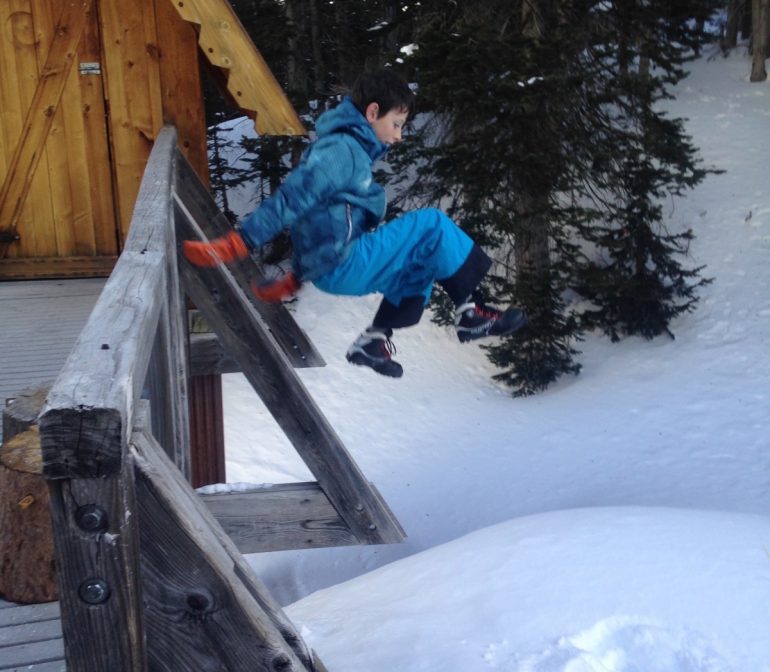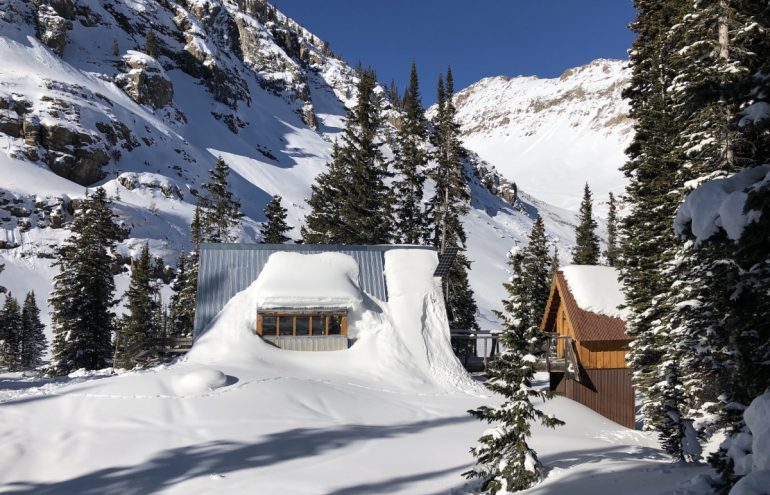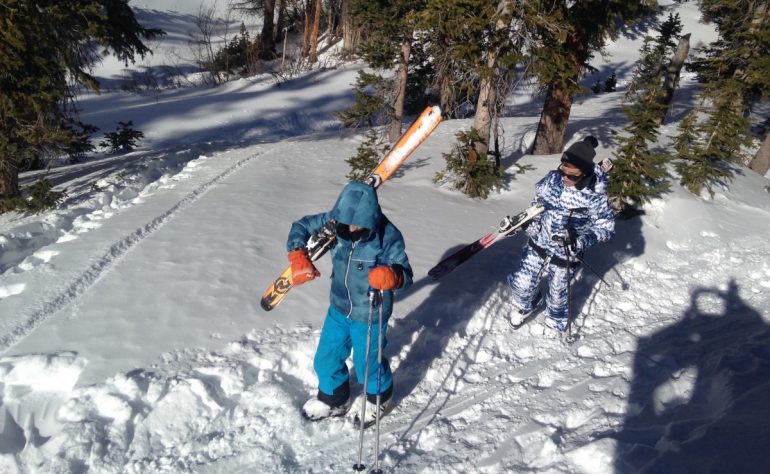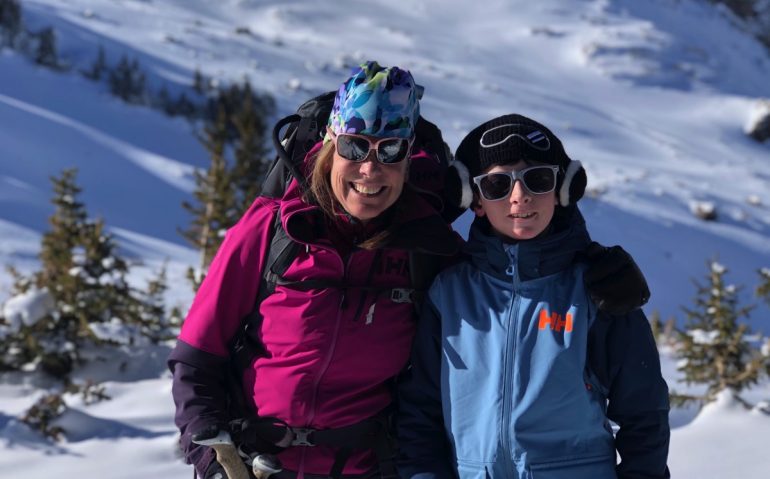“Thank you for bringing me on this trip,” said Johnny. He’d already told it to me at least half a dozen times over the past day. “I know I keep saying that, but I really love it here,” he added.
We were standing outside the Green-Wilson Hut, part of the Braun system south of Aspen, and this was 12-year-old Johnny’s first overnight backcountry ski outing. He and Griffin, my 12-year-old son, were busily digging a network of snow tunnels outside the hut. It was nice to see them maneuvering avalanche shovels instead of Xbox controllers.
I could have happily listened to Johnny tell me all day long how much he was loving our two-night trip. (“I like the freedom of it,” he’d said that morning. “And it’s like you’re waking up right in the ski area.”) I love hut trips, too; they’re one of my favorite things to do on skis. Since my first trip to 10th Mountain Hut Margy’s 26 years ago, navigating my way on lace-up leather Merrell tele boots and 200-plus-length skis, I’ve been hooked.
So when I had a kid, I couldn’t wait until he seemed old enough to bring on a winter hut trip.
Before I figured out the best approach to take, I already knew some things I didn’t want to do. I’d once been on a trip with a group of friends that included one couple and their several-month-old baby. It was a three-night, two-hut trip, and by the time the group reached the second hut—in the dark, after breaking trail for 8 miles—the child resembled a very large popsicle. I made a mental note that when I had a kid and brought him/her to a hut, it would not involve miles of trail nor route finding between destinations.
In the middle of the night, when the baby cried, I cringed, thinking of the strangers we shared the hut with. Mental note number two: when bringing small kids, book the whole hut.
I also started paying attention to anecdotes from other hut trips. A friend told me about one she was on with a couple who demanded that everyone else in the group carry all of their food and gear so they could pull their young ones in on sleds. When it was that couple’s turn to provide breakfast for the group, they handed each person one instant oatmeal packet … but that’s for another story on hut trip meal etiquette.
Anyway, when Griffin was six, I booked the Markley Hut for a night. It’s part of the Braun system, which requires users to reserve the whole hut, so I knew we wouldn’t be disturbing any other guests. The 2.3-mile route in gradually gains 900 feet of elevation on a summer jeep road, which Griffin, an avid hiker, could easily handle. The one caveat: the trail passes under several areas with avvy potential, a risk I deemed low enough to be comfortable taking. Markley also happens to be where my husband and I got engaged, so it seemed fitting to return almost nine years later with our progeny in tow.
The hut sleeps eight, so we invited another active family with a daughter who was born a week before Griffin and a son who’s a couple of years older. Since the kids couldn’t yet fit into AT boots and only Griffin had done much Nordic skiing, my friend—and fellow trip mom—Cammie proposed having them hike up on snowshoes. We’d pack in their downhill gear so they could confidently enjoy the ski out.
Griffin carried a day pack with snacks and water (and wore a beacon), while my husband and I stuffed his sleeping bag and clothing into our own packs.
After a mid-morning start, we took our time on the way in, stopping for a couple of water and food breaks, and arriving with plenty of daylight left for the kids to play in the snow while coming inside for hot chocolate breaks. They got a first taste of hut chores—melting snow for water, stoking the wood stove, restocking logs and kindling. And they experienced the wonderful coziness of having a warm refuge deep in the woods.
By the next morning, a few inches of snow had fallen, and the kids zoomed down the trail on their alpine skis, getting in some easy powder turns.
For the first time, I measured the success of a hut trip not in terms of how much skiing I got in or how good the snow was, but by the fun Griffin had—and he did have fun.
Since then, he’s gone on a half a dozen more hut trips with us. Each time our group has occupied the whole hut; having other kids along to encourage each other on the trail and to play with at the hut are also key factors.
While Griffin willingly embraces the rustic set-up of most huts, he still speaks fondly of his second trip, to the relatively plush Shrine Mountain Inn with its toilets and running water. Another highlight: jumping off the deck into pillows of powder below with several other kids.
We’ve gradually increased the distance we’ll go to reach a hut, the amount of weight that Griffin carries in his pack, and even the size of that pack. As he’s gotten older, we’ve also tweaked his gear. For the 2.3-mile (each way) ski to and from Shrine Mountain, for example, he used cross-country skis both ways (with wax for grip on the gentle 629 vertical foot climb). He started Nordic skiing with his classmates in kindergarten and is quite proficient. Then again, a friend’s athletic sons also held their own on cross-country skis on a hut trip we took together, even without much practice. On a couple of longer trips, Griffin cross-country skied while my husband carted in his downhill skis and boots on a sled for the way out. Having AT boots available in kids sizes and flexes certainly would have made things easier.
This gear progression worked for us because going to a hut as a family has been about the experience of being there and unplugging rather than a lot of skinning and skiing—mainly because dealing with avalanche terrain while backcountry touring is a whole different ballgame when kids are involved.
But I knew it was only a matter of time (and growing feet) before an AT set-up would be the gear of choice. When we visited the Tagert Hut two years ago, Griffin and a friend boot-packed up small slopes around the structure, alpine skis on their shoulders, then skied down, creating their own mini ski area, named runs and all.
On our Green-Wilson trip this past December (5.3 miles in and 1,769 feet of elevation gain) Griffin had progressed into a full-fledged hut tripper. These days, he skis up the trail faster and more efficiently than I do. We rented AT boots, skis, and skins for him (he then asked for a set-up of his own for his birthday). He carried my old Dana Bomb backpack, with his clothing, sleeping bag, toiletries, book, water, and food. He did his fair share of hut chores. And, for the first time, we ski toured on our layover day (while making conservative terrain choices). And Johnny, though a novice, tackled the trip like a champ with our guidance and Griffin’s encouragement. The two boys will be well ahead of the game when their seventh-grade class goes to Margy’s Hut in a couple of weeks.
I have lots of great memories from the past six years of sharing hut trips with my son, but perhaps this one stands out the most. After we arrived at the Tagert Hut—a step-up in challenge at the time—Griffin announced, “It was a lot of work to get up here, but it was worth it.” Yes, that brought some tears to this passionate hut-tripping mom’s eyes.
Where to go
Several Colorado huts or yurts are well suited for introducing kids to the magic of backcountry ski trips. Readers: do you know of huts in your area specifically well-suited for kids? Leave recommendations in the comments.
Overseen by the 10th Mountain Division Hut Association, the adjacent Continental Divide and Point Breeze cabins are less than a mile ski or snowshoe in from the trailhead at Tennessee Pass with 100 feet of elevation gain. Each hut sleeps eight and is rented to one group at a time; both huts are outfitted with two portable cribs and a highchair. The three cabins that make up the Shrine Mountain Inn are a manageable 2.3 miles from the trailhead at the top of Vail Pass, with 629 feet of ascent. Walter’s and Chuck’s cabins have separated upstairs and downstairs sections, each of which hold six guests and must be booked by one group. At 3.1 miles in and with 776 feet of elevation gain, Vance’s Cabin is also very accessible; the hut sleeps 16, so you’d want a large group to book the whole hut.
In the Alfred A. Braun Hut Systems, Markley (2.3 miles, 900 feet elevation gain) and Lindley (4 miles, 982 feet elevation gain) make for good family destinations as long as you accept the risk of passing under some avvy chutes on the trail. Markley sleeps eight, and Lindley sleeps 16; both huts must be booked by one group.
The very civilized High Lonesome Hut near Winter Park is accessed via a 2.5-mile trail with some 600 feet of vertical gain. The hut sleeps 12, has indoor plumbing. Not only are kids welcome but also (because: indoor running water) dogs.
All eight of the backcountry yurts in the Never Summer Nordic system near Walden are family friendly. Distances from trailhead to yurt range from a barely trackable .25 miles to 2.8 miles, with the largest elevation gain at 584 feet (over a couple of miles). Each yurt must be booked by one group.
Shop kid’s touring gear.
Cindy Hirschfeld has been writing about skiing and other outdoor adventures only slightly longer than when she took her first hut trip more than 25 years ago. She is also the editor-in-chief of Aspen Sojourner magazine. She lives in Basalt, Colorado, with her husband and son, and their cat and dog.
Cindy Hirschfeld works and skis from her home in Basalt, Colorado. A former editor at Skiing and Backcountry magazines, and currently the editor-in-chief of Aspen Sojourner magazine, she’s been testing and writing about gear for more than 20 years. Her favorite days are spent in the backcountry.




